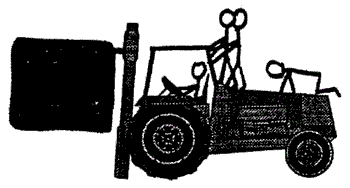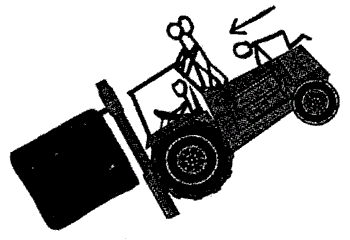Worker Falls From Tipping Forklift
Nebraska Case Report: 96NE045
Report Release Date: February 3, 1997
Summary
A 45-year-old warehouse laborer died as a result of injuries sustained when he fell from a forklift which tipped forward. The forklift operator was attempting to lift a load which was too heavy for the forklift. After it first tipped forward , three coworkers got on the back of it to act as counterweight. It tipped forward again and the victim fell forward landing on his head and shoulder on a gravel surface. After the incident, he was bleeding from his nose and complained that his shoulder hurt. Emergency services were called and upon arrival transported the victim to the hospital where he later lost consciousness. He underwent surgery to relieve pressure from the brain. He never regained consciousness, was removed from a respirator 10 days later and died.
The Nebraska Department of Labor investigator concluded that to prevent future similar occurrences:
- Employers and employees must ensure that unauthorized personnel do not ride on forklifts.
- Employers and employees must ensure that forklifts are operated in accordance with manufacturer’s operating procedures and that only loads within the rated capacity of the forklift are handled.
- Employers should consider implementing a spot inspection program to ensure all employees are complying with safety requirements and develop and enforce consequences for noncompliance.
Program Objective
The goal of the Fatality Assessment and Control Evaluation (FACE) workplace investigation is to prevent work-related deaths or injuries in the future by a study of the working environment, the worker, the task the worker was performing, the tools the worker was using, and the role of management in controlling how these factors interact.
This report is generated and distributed solely for the purpose of providing current, relevant education to employers, their employees and the community on methods to prevent occupational fatalities and injuries.
Introduction
On November 1, 1996, at approximately 12:30 p.m., a 45-year-old warehouse laborer fell from the back of a forklift. He later died on November 11, 1996, from injuries sustained in the fall. The Nebraska Department of Labor was notified of the fatality by OSHA on November 15,1996. Information for the report was obtained from a visit with the OSHA Compliance Officer who conducted a site investigation. The Nebraska FACE investigator also conducted an interview with the company safety director. The employer is in the steel distribution business and has been in business for 9 years. They employ 25 people and this was the first fatality in their history. The company has a written safety program and a full time safety director.
The victim had been employed with the company for 4 1/2 months and had been trained as a forklift operator.
Investigation
At the time of the incident the forklift operator was unloading a flatbed tractor with a forklift (figure 1). The material on the flatbed was sheet steel and was separated into two packages that were intended to be lifted separately. The forklift operator said because it was so cold outside and since both bundles of steel were going to the same location he wanted to lift both bundles at the same time. The forklift was rated for a maximum of 14,000 pounds and the combined weight of the two bundles, as listed on the packing list, was 15,273.42 pounds. The operator was aware of the maximum load for the forklift but thought it could handle the load. He attempted to lift both bundles and realized the forklift was not stable. He called three other employees over to get on the back of the forklift to act as counterweight. Two employees got on and held on to the back of the cab and the third employee (the victim) kneeled on the very back of the forklift (figure 2).
The mast of the forklift was lifted approximately ten to ten and one-half feet in the air. This was necessary for the drooping load to clear the flatbed trailer. One bundle of steel was 6 x 20 feet and the other one was 6 x 17 feet and they drooped off the sides of the forks when the load was lifted. When the forklift backed away from the trailer the forklift tipped forward on its forks (figure 3). At this time the victim was thrown forward from his kneeling position and landed on the ground to the right of the forklift. He fell approximately eight feet. After the victim fell, the forklift operator told the other two individuals on the forklift to get down and pull the victim away from the forklift. The forklift’s rear wheels were still off the ground at this time and the operator was afraid the forklift would come down and crush the victim. After he was moved, the back of the forklift was lowered to the ground.
The victim was bleeding from his nose and complained that his shoulder hurt. The incident occurred at approximately 12:30 a.m. and emergency services were called and they arrived in 16 minutes. When they arrived the victim was still conscious and responding. The victim was taken to the hospital where he lost consciousness and went into respiratory distress at 1:27 a.m. He was in surgery from 3:00 a.m. to 9:30 a.m. to relieve pressure on the brain. The victim sustained brain damage and was removed from the respirator 10 days later on November 11, 1996 and died at 3:26 p.m. the same day.
Cause of Death
The cause of death as stated on the death certificate was acute left subdural hematoma with severe swelling of the left hemisphere and left temporal fracture through base due to closed head injury.
Recommendations/Discussion
Recommendation #1: Employer and employees must ensure that unauthorized personnel do not ride on forklifts.
Discussion: 29 CFR 1910.178 (m) (3) states, “Unauthorized personnel shall not be permitted to ride on powered industrial trucks.” Had the victim not been riding on the rear of the forklift the fatality may have been prevented.
Recommendation #2: Employers and employees must ensure that forklifts are operated in accordance with manufacturer’s operating procedures and that only loads within the rated capacity of the forklift ate handled.
Discussion: The fact that the load exceeded the capacity of this forklift is the reason it tipped forward. A load chart listing the allowable weights for the forklift was clearly posted on the forklift. The operator was aware of the maximum load and should never have exceeded it. When he did and the forklift tipped forward the first time, he should have lowered the double load he had attempted to lift and picked up just the single load. In absolutely no case should personnel ever be used as counterweight.
Recommendation #3: Employers should consider implementing a spot inspection program to ensure all employees are complying with safety requirements and develop and enforce consequences for noncompliance.
Discussion: To ensure safety program compliance, spot inspections by supervisors and management should be conducted regularly, during all shifts, to verify proper procedures are being followed. These spot inspections should be documented and deterrent consequences enforced when violations are detected. An effective Injury Prevention Program should instill an attitude in everyone that safety will never be compromised.
Reference
Office of the Federal Register, National Archives and Records Administration, Code of Federal Regulations, Labor, 29 CFR 1910.178, 1995.
Figures

|

|

|
|
Figure 3. When forklift tipped forward, victim fell forward and landed at right front of forklift.
|
To contact Nebraska State FACE program personnel regarding State-based FACE reports, please use information listed on the Contact Sheet on the NIOSH FACE web site Please contact In-house FACE program personnel regarding In-house FACE reports and to gain assistance when State-FACE program personnel cannot be reached.
